-
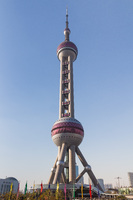 The Oriental Pearl Tower
The Oriental Pearl Tower The Oriental Pearl Radio &Television Tower is a skyscraper in Pudong's Lujiazui district.
-
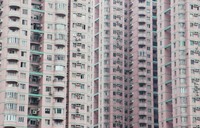 Soviet Style Apartments
Soviet Style Apartments Soviet style apartments in Shenzhen, China.
-
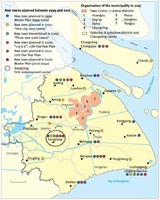 New Satellite Towns Planned Between 1999 and 2017
New Satellite Towns Planned Between 1999 and 2017 A map of the Shanghai region which labels all of the satellite towns planned between 1999 and 2017.
-
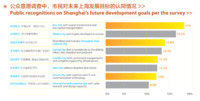 Shanghai Future Development Goals
Shanghai Future Development Goals The Shanghai Master Plan 2017-2035 asserts that its goals are supported by the public.
-
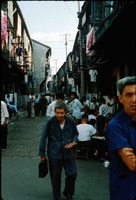 Street Scene 1982
Street Scene 1982 A street scene depicting a moment of life in a Lilong alleyway community. Until the 2000s, the majority of Shanghai's population resided in Lilong houses.
-
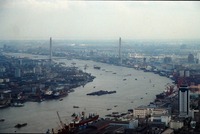 View of the Yangpu Bridge and Pudong from the Oriental Pearl Tower
View of the Yangpu Bridge and Pudong from the Oriental Pearl Tower A photograph of the Yangpu Bridge, which spans the Huangpu river to connect Pudong to the rest of the city.
-
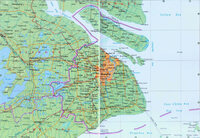 Shanghai Municipality Map 2010
Shanghai Municipality Map 2010 A detailed map of the Shanghai Municipality as of 2010.
-
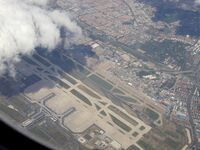 Shanghai Hongqiao International Airport
Shanghai Hongqiao International Airport An aerial view of Shanghai's Hongqiao International Airport. The large terminal in the lower left of the image was constructed in preparation for Expo 2010.
-
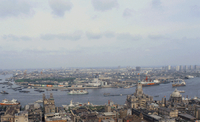 Pudong Skyline in 1987
Pudong Skyline in 1987 An image of the Lujiazui district in Pudong in 1987 as scene from the Bund.
-
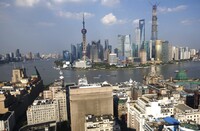 Pudong Skyline in 2013
Pudong Skyline in 2013 An image showing the remarkable skyline of Pudong's Lujiazui financial district in 2013.
-
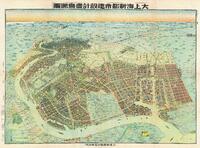 Greater Shanghai Metropolitan Plan
Greater Shanghai Metropolitan Plan A Japanese plan for Shanghai that was heavily inspired by the Greater Shanghai Plan.
-
 The Chinese Pavilion at Expo 2010
The Chinese Pavilion at Expo 2010 An exterior view of the Chinese national pavilion at Shanghai Expo 2010.
-
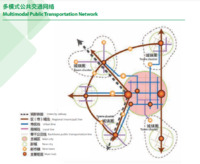 Multimodal Transport Network
Multimodal Transport Network A plan for Shanghai's new multimodal transport network. It extends from the city center into urban clusters in the surrounding area. The network is intended to reduce the population in Shanghai by making it possible to commute to jobs from outside the city.
-
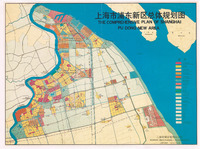 The Comprehensive Plan of Shanghai Pudong New Area
The Comprehensive Plan of Shanghai Pudong New Area A plan of the Pudong New Area. It details the intended uses of various portions of Pudong. As of 1991, the plan had not yet been enacted in its entirety.
-
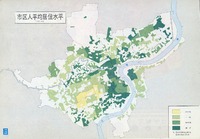 Average Residential Space Per Person in Shanghai Urban Area
Average Residential Space Per Person in Shanghai Urban Area A map showing the amount of space per person in Shanghai. It was published in 1984 but used data from 1979. It reveals how crowded Shanghai was following years of neglect and decay.
Key:
Yellow- Fairly large
Light Green- Regular
Green- Rather crowded
Dark Green- Crowded
-
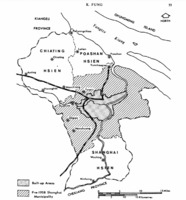 Proposed Satellite Towns in the Shanghai Region, 1958
Proposed Satellite Towns in the Shanghai Region, 1958 A map that outlines the potential locations of satellite towns in the Shanghai region as of 1958. This plan was only ever partially implemented.
-
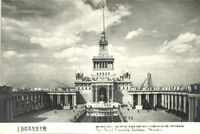 The Sino-Soviet Friendship Building
The Sino-Soviet Friendship Building A postcard depicting the Sino-Soviet Friendship Building. The building was later renamed the Shanghai Exhibition Centre following the deteriorating relationship between the USSR and the PRC.
-
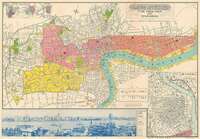 The New Map of Shanghai
The New Map of Shanghai A map made after the Imperial Japanese army occupied Shanghai. The inset displays a part of the Zhabei district, an area which saw a great deal of military action and so was of interest to the Japanese as a potential sight for new development.
-
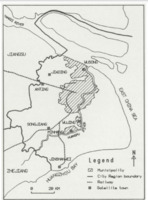 Satellite Towns in Shanghai City Region 1987
Satellite Towns in Shanghai City Region 1987 A map of all the seven successful satellite towns in the Shanghai City region as of 1987.
-
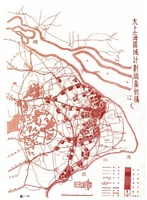 First Draft of Shanghai Master Plan
First Draft of Shanghai Master Plan The first draft of a post-WW2 plan for Shanghai.
-
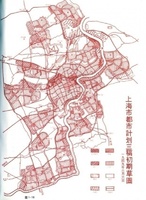 Third Draft of Shanghai Master Plan
Third Draft of Shanghai Master Plan A post-WW2 design for Shanghai that emphasized broad regional planning.
-
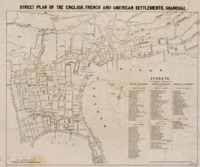 Street plan of the English, French and American settlements
Street plan of the English, French and American settlements This map depicts the street plan of the English, French, and American settlements in Shanghai as of 1870. The map was created by the English mapmaking company Stanford's Geographical Establishment in order to be published in the English-language Shanghai newspaper North China Daily News. The map has a 1 : 10,200 scale and is oriented more or less North to South, though it is rotated slightly clockwise. While the map lacks a conventional legend, it does have a list of every major street in each of the foreign settlements off to the side. These streets are also labelled on the map, which also notes some significant locations or landmarks.
The North China Daily News was the most influential foreign newspaper in China from the mid 19th to early 20th centuries. Its audience would primarily have been the Shanghai's English-speaking population of English and Americans. The map reflects this, as it transliterates the Chinese names of streets into the English alphabet. Somewhat interestingly, the map leaves the names of streets in the French settlement unchanged, using French words like "rue" (street). While the map depicts the foreign settlements in great detail, it leaves a large blank space where the old walled city of Shanghai would be. This might indicate that that area was thought of as irrelevant to the readers of the North China Daily News, implying that foreigners rarely visited the Chinese part of the city. Furthermore, that the map depicts all of the foreign settlements implies that foreigners moved between settlements instead of simply remaining in those of their respective nations. People only need detailed street maps of places they intend to visit.
-
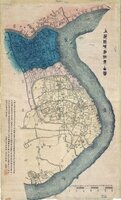 Shanghai 1884
Shanghai 1884 Originally drawn by Yucang Xu in 1875, later edited and published by Dian She Zhai in 1884, this map depicts the urban layout of Shanghai in 1884. The map includes both the county and foreign concessions with distinctions as follows: Chinese area in yellow, French in red, British in blue, and American in orange. The map contains Chinese text, describing various locations in the city.
The Huangpu river takes up the right portion of the map, and using it as a geographical marker sans included compass allows us to assume the top portion of the map corresponds to north, and the bottom portion the south. The map is scaled 1:5400 and was originally drawn on paper, measuring 110 x 66 cm.
-
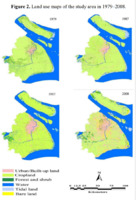 Land use maps of the Shanghai area
Land use maps of the Shanghai area Between 1979 and 2008 urban land in the Shanghai area increased by 210.18%.
-
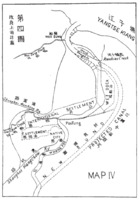 Plan to rechannel the Huangpu River
Plan to rechannel the Huangpu River In his book The International Development of China, Sun Yat-sen outlined a plan to reroute the Huangpu River in order to create a "New Bund" for Shanghai.
 The Oriental Pearl Tower The Oriental Pearl Radio &Television Tower is a skyscraper in Pudong's Lujiazui district.
The Oriental Pearl Tower The Oriental Pearl Radio &Television Tower is a skyscraper in Pudong's Lujiazui district. Soviet Style Apartments Soviet style apartments in Shenzhen, China.
Soviet Style Apartments Soviet style apartments in Shenzhen, China. New Satellite Towns Planned Between 1999 and 2017 A map of the Shanghai region which labels all of the satellite towns planned between 1999 and 2017.
New Satellite Towns Planned Between 1999 and 2017 A map of the Shanghai region which labels all of the satellite towns planned between 1999 and 2017. Shanghai Future Development Goals The Shanghai Master Plan 2017-2035 asserts that its goals are supported by the public.
Shanghai Future Development Goals The Shanghai Master Plan 2017-2035 asserts that its goals are supported by the public. Street Scene 1982 A street scene depicting a moment of life in a Lilong alleyway community. Until the 2000s, the majority of Shanghai's population resided in Lilong houses.
Street Scene 1982 A street scene depicting a moment of life in a Lilong alleyway community. Until the 2000s, the majority of Shanghai's population resided in Lilong houses. View of the Yangpu Bridge and Pudong from the Oriental Pearl Tower A photograph of the Yangpu Bridge, which spans the Huangpu river to connect Pudong to the rest of the city.
View of the Yangpu Bridge and Pudong from the Oriental Pearl Tower A photograph of the Yangpu Bridge, which spans the Huangpu river to connect Pudong to the rest of the city. Shanghai Municipality Map 2010 A detailed map of the Shanghai Municipality as of 2010.
Shanghai Municipality Map 2010 A detailed map of the Shanghai Municipality as of 2010. Shanghai Hongqiao International Airport An aerial view of Shanghai's Hongqiao International Airport. The large terminal in the lower left of the image was constructed in preparation for Expo 2010.
Shanghai Hongqiao International Airport An aerial view of Shanghai's Hongqiao International Airport. The large terminal in the lower left of the image was constructed in preparation for Expo 2010. Pudong Skyline in 1987 An image of the Lujiazui district in Pudong in 1987 as scene from the Bund.
Pudong Skyline in 1987 An image of the Lujiazui district in Pudong in 1987 as scene from the Bund. Pudong Skyline in 2013 An image showing the remarkable skyline of Pudong's Lujiazui financial district in 2013.
Pudong Skyline in 2013 An image showing the remarkable skyline of Pudong's Lujiazui financial district in 2013. Greater Shanghai Metropolitan Plan A Japanese plan for Shanghai that was heavily inspired by the Greater Shanghai Plan.
Greater Shanghai Metropolitan Plan A Japanese plan for Shanghai that was heavily inspired by the Greater Shanghai Plan. The Chinese Pavilion at Expo 2010 An exterior view of the Chinese national pavilion at Shanghai Expo 2010.
The Chinese Pavilion at Expo 2010 An exterior view of the Chinese national pavilion at Shanghai Expo 2010. Multimodal Transport Network A plan for Shanghai's new multimodal transport network. It extends from the city center into urban clusters in the surrounding area. The network is intended to reduce the population in Shanghai by making it possible to commute to jobs from outside the city.
Multimodal Transport Network A plan for Shanghai's new multimodal transport network. It extends from the city center into urban clusters in the surrounding area. The network is intended to reduce the population in Shanghai by making it possible to commute to jobs from outside the city. The Comprehensive Plan of Shanghai Pudong New Area A plan of the Pudong New Area. It details the intended uses of various portions of Pudong. As of 1991, the plan had not yet been enacted in its entirety.
The Comprehensive Plan of Shanghai Pudong New Area A plan of the Pudong New Area. It details the intended uses of various portions of Pudong. As of 1991, the plan had not yet been enacted in its entirety. Average Residential Space Per Person in Shanghai Urban Area A map showing the amount of space per person in Shanghai. It was published in 1984 but used data from 1979. It reveals how crowded Shanghai was following years of neglect and decay. Key: Yellow- Fairly large Light Green- Regular Green- Rather crowded Dark Green- Crowded
Average Residential Space Per Person in Shanghai Urban Area A map showing the amount of space per person in Shanghai. It was published in 1984 but used data from 1979. It reveals how crowded Shanghai was following years of neglect and decay. Key: Yellow- Fairly large Light Green- Regular Green- Rather crowded Dark Green- Crowded Proposed Satellite Towns in the Shanghai Region, 1958 A map that outlines the potential locations of satellite towns in the Shanghai region as of 1958. This plan was only ever partially implemented.
Proposed Satellite Towns in the Shanghai Region, 1958 A map that outlines the potential locations of satellite towns in the Shanghai region as of 1958. This plan was only ever partially implemented. The Sino-Soviet Friendship Building A postcard depicting the Sino-Soviet Friendship Building. The building was later renamed the Shanghai Exhibition Centre following the deteriorating relationship between the USSR and the PRC.
The Sino-Soviet Friendship Building A postcard depicting the Sino-Soviet Friendship Building. The building was later renamed the Shanghai Exhibition Centre following the deteriorating relationship between the USSR and the PRC. The New Map of Shanghai A map made after the Imperial Japanese army occupied Shanghai. The inset displays a part of the Zhabei district, an area which saw a great deal of military action and so was of interest to the Japanese as a potential sight for new development.
The New Map of Shanghai A map made after the Imperial Japanese army occupied Shanghai. The inset displays a part of the Zhabei district, an area which saw a great deal of military action and so was of interest to the Japanese as a potential sight for new development. Satellite Towns in Shanghai City Region 1987 A map of all the seven successful satellite towns in the Shanghai City region as of 1987.
Satellite Towns in Shanghai City Region 1987 A map of all the seven successful satellite towns in the Shanghai City region as of 1987. First Draft of Shanghai Master Plan The first draft of a post-WW2 plan for Shanghai.
First Draft of Shanghai Master Plan The first draft of a post-WW2 plan for Shanghai. Third Draft of Shanghai Master Plan A post-WW2 design for Shanghai that emphasized broad regional planning.
Third Draft of Shanghai Master Plan A post-WW2 design for Shanghai that emphasized broad regional planning. Street plan of the English, French and American settlements This map depicts the street plan of the English, French, and American settlements in Shanghai as of 1870. The map was created by the English mapmaking company Stanford's Geographical Establishment in order to be published in the English-language Shanghai newspaper North China Daily News. The map has a 1 : 10,200 scale and is oriented more or less North to South, though it is rotated slightly clockwise. While the map lacks a conventional legend, it does have a list of every major street in each of the foreign settlements off to the side. These streets are also labelled on the map, which also notes some significant locations or landmarks. The North China Daily News was the most influential foreign newspaper in China from the mid 19th to early 20th centuries. Its audience would primarily have been the Shanghai's English-speaking population of English and Americans. The map reflects this, as it transliterates the Chinese names of streets into the English alphabet. Somewhat interestingly, the map leaves the names of streets in the French settlement unchanged, using French words like "rue" (street). While the map depicts the foreign settlements in great detail, it leaves a large blank space where the old walled city of Shanghai would be. This might indicate that that area was thought of as irrelevant to the readers of the North China Daily News, implying that foreigners rarely visited the Chinese part of the city. Furthermore, that the map depicts all of the foreign settlements implies that foreigners moved between settlements instead of simply remaining in those of their respective nations. People only need detailed street maps of places they intend to visit.
Street plan of the English, French and American settlements This map depicts the street plan of the English, French, and American settlements in Shanghai as of 1870. The map was created by the English mapmaking company Stanford's Geographical Establishment in order to be published in the English-language Shanghai newspaper North China Daily News. The map has a 1 : 10,200 scale and is oriented more or less North to South, though it is rotated slightly clockwise. While the map lacks a conventional legend, it does have a list of every major street in each of the foreign settlements off to the side. These streets are also labelled on the map, which also notes some significant locations or landmarks. The North China Daily News was the most influential foreign newspaper in China from the mid 19th to early 20th centuries. Its audience would primarily have been the Shanghai's English-speaking population of English and Americans. The map reflects this, as it transliterates the Chinese names of streets into the English alphabet. Somewhat interestingly, the map leaves the names of streets in the French settlement unchanged, using French words like "rue" (street). While the map depicts the foreign settlements in great detail, it leaves a large blank space where the old walled city of Shanghai would be. This might indicate that that area was thought of as irrelevant to the readers of the North China Daily News, implying that foreigners rarely visited the Chinese part of the city. Furthermore, that the map depicts all of the foreign settlements implies that foreigners moved between settlements instead of simply remaining in those of their respective nations. People only need detailed street maps of places they intend to visit. Shanghai 1884 Originally drawn by Yucang Xu in 1875, later edited and published by Dian She Zhai in 1884, this map depicts the urban layout of Shanghai in 1884. The map includes both the county and foreign concessions with distinctions as follows: Chinese area in yellow, French in red, British in blue, and American in orange. The map contains Chinese text, describing various locations in the city. The Huangpu river takes up the right portion of the map, and using it as a geographical marker sans included compass allows us to assume the top portion of the map corresponds to north, and the bottom portion the south. The map is scaled 1:5400 and was originally drawn on paper, measuring 110 x 66 cm.
Shanghai 1884 Originally drawn by Yucang Xu in 1875, later edited and published by Dian She Zhai in 1884, this map depicts the urban layout of Shanghai in 1884. The map includes both the county and foreign concessions with distinctions as follows: Chinese area in yellow, French in red, British in blue, and American in orange. The map contains Chinese text, describing various locations in the city. The Huangpu river takes up the right portion of the map, and using it as a geographical marker sans included compass allows us to assume the top portion of the map corresponds to north, and the bottom portion the south. The map is scaled 1:5400 and was originally drawn on paper, measuring 110 x 66 cm. Land use maps of the Shanghai area Between 1979 and 2008 urban land in the Shanghai area increased by 210.18%.
Land use maps of the Shanghai area Between 1979 and 2008 urban land in the Shanghai area increased by 210.18%. Plan to rechannel the Huangpu River In his book The International Development of China, Sun Yat-sen outlined a plan to reroute the Huangpu River in order to create a "New Bund" for Shanghai.
Plan to rechannel the Huangpu River In his book The International Development of China, Sun Yat-sen outlined a plan to reroute the Huangpu River in order to create a "New Bund" for Shanghai.